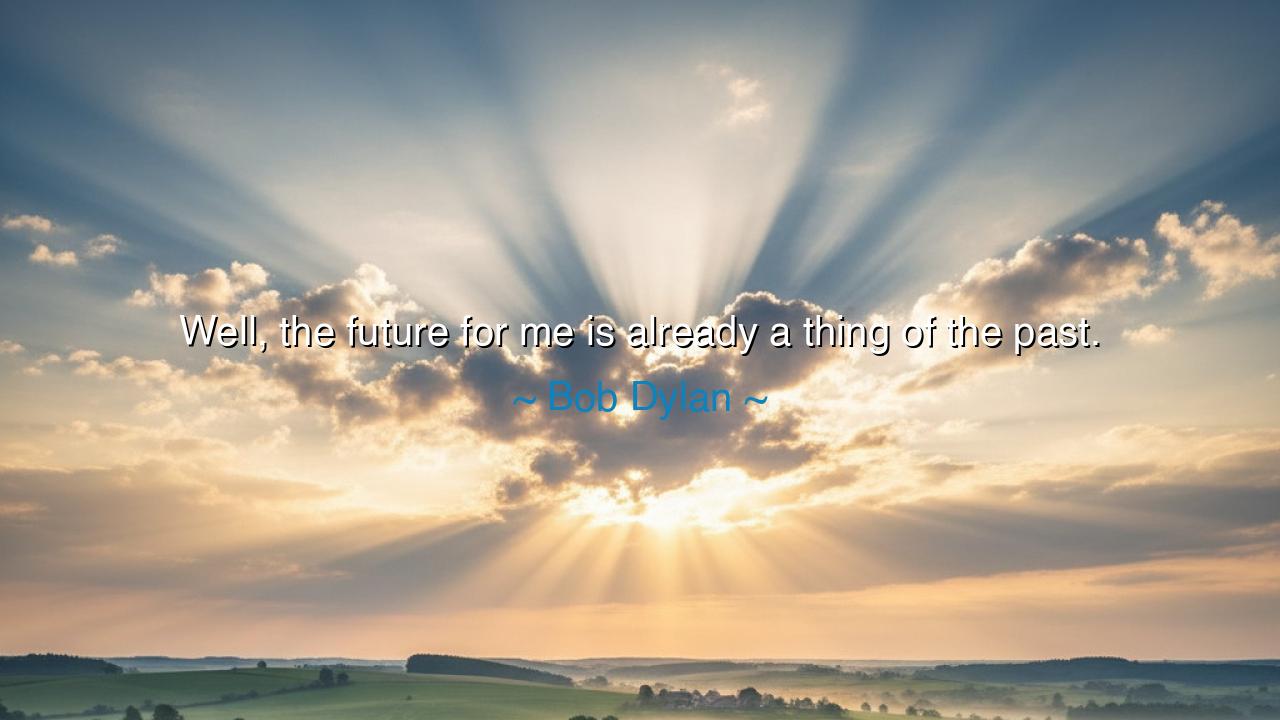
Well, the future for me is already a thing of the past.






In the labyrinth of time, where past, present, and future intertwine, Bob Dylan’s words pierce through with an evocative truth: “Well, the future for me is already a thing of the past.” In this seemingly paradoxical statement, Dylan touches upon the impermanence of time, the fleeting nature of our expectations, and the deep truth that the future is often shaped and influenced by what has come before. The future, as we imagine it, can slip through our fingers like sand, constantly influenced by the events that have already passed. Dylan, in his poetic and mystical way, reminds us that time is not a linear progression but a tapestry of experiences, memories, and choices, each one bleeding into the other.
The ancient philosophers, particularly the Stoics, understood the complexities of time. Marcus Aurelius, in his reflections on life and purpose, spoke often of the importance of recognizing the present moment and accepting the things we cannot control. He understood that while we cannot change the past, nor can we predict the future, the only true power we possess lies in how we act in the now. Dylan’s sentiment echoes this Stoic understanding, where the future is not something we can fixate on or predict—it is always influenced by the weight of the past. Just as Aurelius counseled that we must live in harmony with the present, Dylan seems to acknowledge that the future, no matter how much we plan, will always be intertwined with the paths we’ve already walked.
Consider the story of Heraclitus, the ancient Greek philosopher who famously said, "You cannot step into the same river twice." His wisdom speaks of the constant flux of life—everything is always changing, yet it is all part of an unbroken whole. The river of time does not stand still; it is ever-moving, and each moment is shaped by the ones that came before. Just as Heraclitus saw change as the essence of the universe, so too does Dylan recognize that the future is not an isolated event but a continuation of all that has passed. The future is already shaped by our actions, by the choices we have made in the past, and by the circumstances we find ourselves in today. In this sense, the future is never truly separate from the past, but an extension of it.
In a similar vein, consider the life of Leonardo da Vinci, whose vision of the future was always shaped by his understanding of the past. Da Vinci’s inventions and art were deeply influenced by the knowledge he absorbed from the great minds of his time. Yet, despite his extraordinary vision of the future, he was always grounded in the knowledge of what had already been discovered and created. His future, filled with imagination and innovation, was rooted in the past, and every invention he made was a continuation of the journey that had come before him. Dylan’s words reflect a similar sentiment: the future is not some separate thing to look forward to, but a part of the cycle of time, always intertwined with what has already been.
The lesson in Dylan’s reflection is one of acceptance and awareness. It is easy to become obsessed with the future—to imagine that it holds all the answers, all the possibilities. But in doing so, we often neglect the power of the present moment and the influence that the past has on us. The future is not something we can control or predict with certainty; it is a continuation of the story we are already living. Just as the ancient philosophers and the great thinkers of history understood, it is in the present that we find our true power, and it is through how we act today that we shape the world of tomorrow.
In our own lives, we must recognize that time is not a distant, linear progression, but an ever-changing flow in which we are active participants. The future will come, but it will always be influenced by the choices we make in the present and the legacy of the past we carry with us. Let us not become paralyzed by fear of the unknown future, but instead, let us focus on what we can do now. Each moment, each decision, each action we take is an extension of the road we’ve already traveled, and it is through these actions that we shape our future.
Let us, then, take Dylan’s words to heart and live fully in the present, embracing the fact that the future is already in motion through the choices we make. The past is behind us, and the future is not guaranteed, but the present—this moment—is where we can make our greatest impact. Live today as if it were the culmination of all that has come before, and all that is yet to come, for in the end, the present is where the future is already being written.






AAdministratorAdministrator
Welcome, honored guests. Please leave a comment, we will respond soon